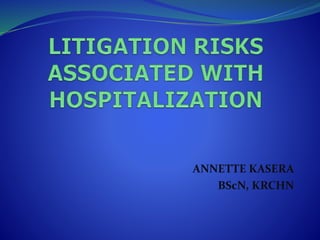
LITIGATION RISKS ASSOCIATED WITH HOSPITALIZATION
- 2. LITIGATION One can easily say that healthcare now is a risky business. A report released in 1999 by the Institute of Medicine indicated that medical errors contributed directly or indirectly to the deaths of between 44,000-98,000 hospitalized patients each year. This report suggested that 90% of these errors result from system failures and not necessarily from individuals. (Valorie Dearmon 2014) A person who alleges negligent medical malpractice must prove four elements: • A duty of care was owed by the Doctor/Nurse. • The Doctor/Nurse violated the applicable standards of care. • The person suffered a compensable injury/death. • The injury/death was directly or indirectly caused by the substandard conduct.
- 3. Discussion MEDICAL MALPRACTICE Medical malpractice is defined as any situation whereby a patient is injured or suffers fatal harm as a direct or indirect result of a healthcare professional. This can include but not limited to: Misdiagnosis or Delayed Diagnosis.
- 4. Childbirth Injuries (failure to diagnose a medical condition of the mother, such as preeclampsia,Rhesus incompatibility, hypoglycemia, anemia, or gestational diabetes, failure to identify birth defects, failure to identify ectopic pregnancies, failure to diagnose a disease that could be contagious to the fetus, failure to anticipate birth complications due to baby or maternal factors, failure to respond to signs of fetal distress, incompetent use of forceps or a vacuum extractor.
- 5. Medication Errors (the doctor prescribes the wrong medication, wrong dosage, the doctor prescribes to treat a misdiagnosed condition, the prescription is correct, but the nurse administers the incorrect amount or incorrect administration method). Anaesthesia Errors (failure to investigate the patient's medical history for possible complications, failure to inform the patient of the risks involved, giving too much anesthesia to the patient, failure to monitor the patient's vital signs, improper intubation of patients and using defective equipment). Surgery Errors (puncturing internal organs, operating on the wrong body part, or leaving surgical instruments in the body, the nursing staff might be negligent in administering post-op care).
- 6. Student nurses can also be held liable for their actions and can be sued. A student nurse is held to the same standard of care as a registered nurse when performing RN duties. If a student nurse cannot safely function in the performance of these duties while unsupervised, then they should not be carrying out the duties (American Nurses Association 2001 Guidelines).
- 7. RISK MANAGEMENT Healthcare risk management is the process healthcare providers and organizations use to reduce the occurrence of unintended injuries or damages during the delivery of medical care. This may vary according to the organizational structure, the type and size of the facility, and the scope and complexity of patient services delivered. (NORCAL Litigation Handbook 2016)
- 8. The goal of the healthcare risk management function is to foster an environment that minimizes risks to patients, visitors and staff, thus reducing the frequency of potentially compensable events or the severity of losses when events do occur. An effective risk management program requires commitment and cooperation from all members of the healthcare team. (NORCAL Litigation Handbook 2016) Risk Management Functions Most risk management programs: Identify, review and investigate unusual incidents.
- 9. Identify potential exposure through a review of existing internal systems related to personnel, policies and procedures, facility equipment and premises, medical record documentation, patient follow-up systems and discharge advice to patients. Develop and implement policies designed to help reduce risk and increase patient safety. Avoid recurrence of accidents or unusual incidents. Advise medical staff and facility management of actions to be taken to improve problem areas. Educate healthcare providers and staff regarding appropriate work practices and patient care systems.
- 10. Assess patient satisfaction with the services rendered by the hospital. Investigate and resolve patient or visitor complaints. Ensure compliance with accreditation standards e.g. JCIA, ISO and all applicable laws and statutory regulations. Coordinate the legal defense process when a claim is forthcoming. (NORCAL Litigation Handbook 2016)
- 11. INFORMED CONSENT This is a process for getting permission before conducting a healthcare intervention on a person. An informed consent can be said to have been given based upon a clear appreciation and understanding of the facts. To give informed consent, the individual must have adequate reasoning faculties and be in possession of all facts. Impairments to reasoning and judgment that may prevent informed consent include basic intellectual or emotional immaturity, high levels of stress such as PTSD, severe intellectual disability, mental illness, intoxication, severe sleep deprivation, Alzheimer's disease, or being in a coma. In cases where an individual is considered unable to give informed consent, another person is generally authorized to give consent on his behalf, e.g., parents or legal guardians of a child (though in this circumstance the child may be required to provide informed assent) and conservators for the mentally ill.
- 14. CONCLUSION The reality of our times is that all of us who work in the healthcare setup are open to lawsuits from disgruntled patients, relatives and aggrieved families. The best we can do to shield ourselves from those outcomes is to continuously improve the quality of care we give, communicate clearly with each other and with our clients about expectations and responsibilities from both sides and to undergo regular audits of our practice in order to identify and rectify any gaps.
- 15. RECOMMENDATIONS • The Nairobi Hospital consent form should be more inclusive of all invasive, non-invasive procedures, surgeries in order to accommodate the variety of services offered at the hospital. • The Nairobi Hospital should have a clear framework for protecting the staff in case of lawsuits. • All of us should make it our mission to clearly explain to patients what procedures are planned for them, the risks involved, the benefits and do this in cooperation with the Doctors.